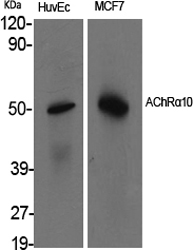AChRα10 Polyclonal Antibody
- Catalog No.:YT0081
- Applications:WB;ELISA
- Reactivity:Human;Mouse;Rat
- Target:
- AChRα10
- Fields:
- >>Neuroactive ligand-receptor interaction
- Gene Name:
- CHRNA10
- Protein Name:
- Neuronal acetylcholine receptor subunit alpha-10
- Human Gene Id:
- 57053
- Human Swiss Prot No:
- Q9GZZ6
- Rat Gene Id:
- 64574
- Rat Swiss Prot No:
- Q9JLB5
- Immunogen:
- The antiserum was produced against synthesized peptide derived from human CHRNA10. AA range:394-443
- Specificity:
- AChRα10 Polyclonal Antibody detects endogenous levels of AChRα10 protein.
- Formulation:
- Liquid in PBS containing 50% glycerol, 0.5% BSA and 0.02% sodium azide.
- Source:
- Polyclonal, Rabbit,IgG
- Dilution:
- WB 1:500 - 1:2000. ELISA: 1:20000. Not yet tested in other applications.
- Purification:
- The antibody was affinity-purified from rabbit antiserum by affinity-chromatography using epitope-specific immunogen.
- Concentration:
- 1 mg/ml
- Storage Stability:
- -15°C to -25°C/1 year(Do not lower than -25°C)
- Other Name:
- CHRNA10;NACHRA10;Neuronal acetylcholine receptor subunit alpha-10;Nicotinic acetylcholine receptor subunit alpha-10;NACHR alpha-10
- Observed Band(KD):
- 50kD
- Background:
- function:Ionotropic receptor with a probable role in the modulation of auditory stimuli. Agonist binding may induce an extensive change in conformation that affects all subunits and leads to opening of an ion-conducting channel across the plasma membrane. The channel is permeable to a range of divalent cations including calcium, the influx of which may activate a potassium current which hyperpolarizes the cell membrane. In the ear, this may lead to a reduction in basilar membrane motion, altering the activity of auditory nerve fibers and reducing the range of dynamic hearing. This may protect against acoustic trauma.,miscellaneous:The hetero-oligomeric receptor composed of CHRNA9 and CHRNA10 has an atypical pharmacological profile, binding several non-nicotinic ligands including strychnine (a glycine receptor antagonist) and atropine (a muscarinic acetylcholine receptor antagonist).,similarity:Belongs to the ligand-gated ionic channel (TC 1.A.9) family.,subunit:Forms hetero-oligomeric channels in conjunction with CHRNA9. The native outer hair cell receptor may be composed of CHRNA9-CHRNA10 hetero-oligomers.,tissue specificity:Expressed in inner-ear tissue, tonsil, immortalized B-cells, cultured T-cells and peripheral blood lymphocytes.,
- Function:
- function:Ionotropic receptor with a probable role in the modulation of auditory stimuli. Agonist binding may induce an extensive change in conformation that affects all subunits and leads to opening of an ion-conducting channel across the plasma membrane. The channel is permeable to a range of divalent cations including calcium, the influx of which may activate a potassium current which hyperpolarizes the cell membrane. In the ear, this may lead to a reduction in basilar membrane motion, altering the activity of auditory nerve fibers and reducing the range of dynamic hearing. This may protect against acoustic trauma.,miscellaneous:The hetero-oligomeric receptor composed of CHRNA9 and CHRNA10 has an atypical pharmacological profile, binding several non-nicotinic ligands including strychnine (a glycine receptor antagonist) and atropine (a muscarinic acetylcholine receptor antagonist).,simi
- Subcellular Location:
- Cell junction, synapse, postsynaptic cell membrane ; Multi-pass membrane protein . Cell membrane ; Multi-pass membrane protein .
- Expression:
- Expressed in inner-ear tissue, tonsil, immortalized B-cells, cultured T-cells and peripheral blood lymphocytes.
- June 19-2018
- WESTERN IMMUNOBLOTTING PROTOCOL
- June 19-2018
- IMMUNOHISTOCHEMISTRY-PARAFFIN PROTOCOL
- June 19-2018
- IMMUNOFLUORESCENCE PROTOCOL
- September 08-2020
- FLOW-CYTOMEYRT-PROTOCOL
- May 20-2022
- Cell-Based ELISA│解您多样本WB检测之困扰
- July 13-2018
- CELL-BASED-ELISA-PROTOCOL-FOR-ACETYL-PROTEIN
- July 13-2018
- CELL-BASED-ELISA-PROTOCOL-FOR-PHOSPHO-PROTEIN
- July 13-2018
- Antibody-FAQs
- Products Images

- Western Blot analysis of various cells using AChRα10 Polyclonal Antibody
.jpg)
- Western Blot analysis of A549 cells using AChRα10 Polyclonal Antibody

- Western blot analysis of lysates from HeLa, 293, COLO, and A549 cells, using CHRNA10 Antibody. The lane on the right is blocked with the synthesized peptide.



